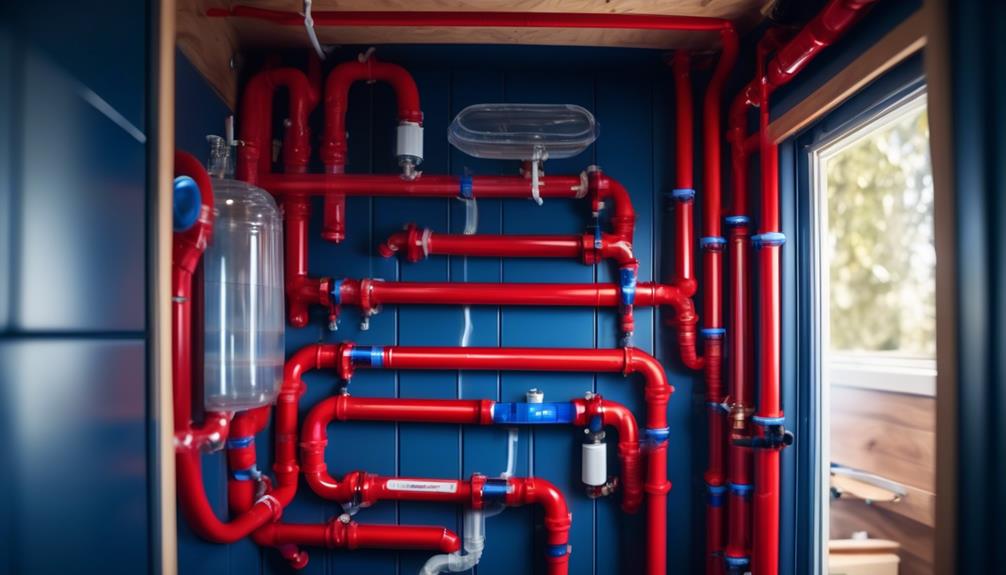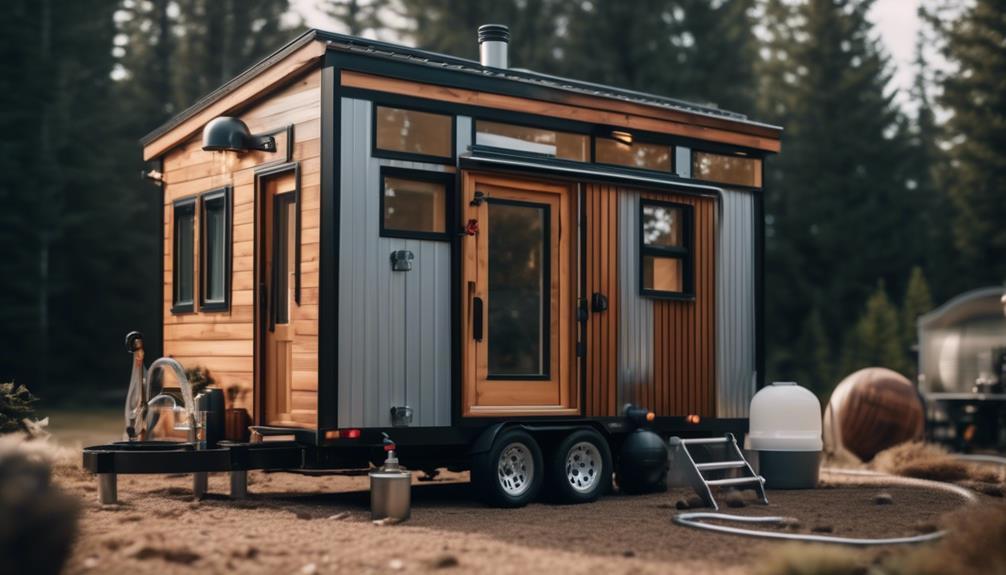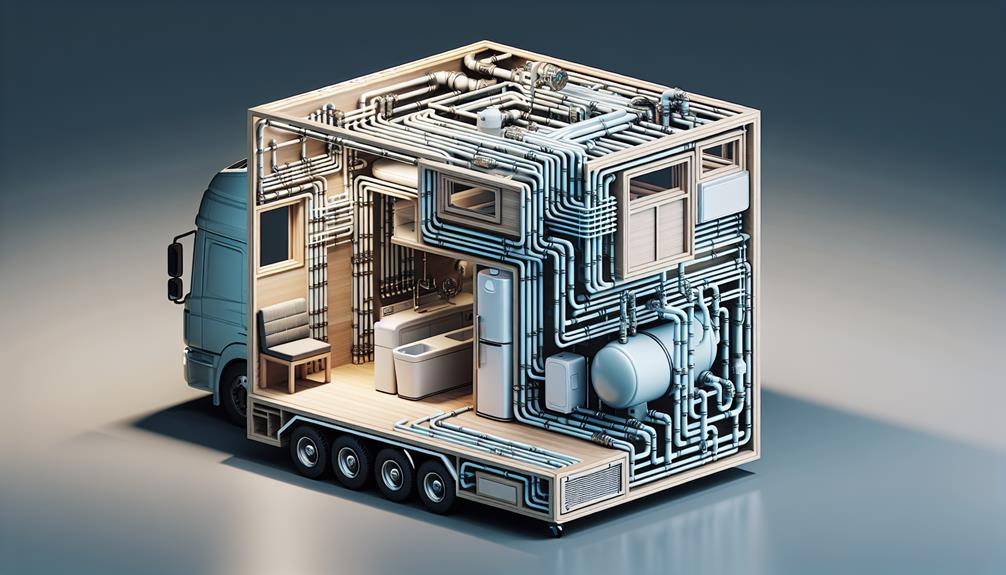As someone who has always been fascinated by the minimalist lifestyle and the freedom it offers, I was surprised to learn that the plumbing system in a tiny house can be quite complex.
Did you know that a tiny house requires a different approach to plumbing compared to a traditional home? Well, in this guide, we will explore the intricacies of tiny house plumbing, from the basics of designing and DIYing your own system to the freedom it provides for off-grid living.
So, if you're curious about how to make the most of your limited space while still having a functional and efficient plumbing system, keep reading. You won't want to miss out on the valuable insights and tips that await you.
Key Takeaways
- Traditional house plumbing and tiny house plumbing have three main differences, including the size of the system, the need for proper planning and design, and the connection to a water supply.
- PEX plumbing is a popular option for tiny houses due to its affordability, ease of installation, freeze resistance, and DIY-friendly nature.
- There are two main methods for water hookup in a tiny house: spigot hookup using a drink-safe hose and RV water inlet, and a more permanent direct connection with a buried PEX line.
- Water tanks are important for off-grid living or traveling in a tiny house, providing self-sufficiency and flexibility in water usage. Considerations for tank size and capacity should be based on individual water usage needs.
Tiny House Plumbing Basics
Tiny house plumbing basics involve understanding the key differences between traditional house plumbing and the unique design considerations required for a compact living space.
When it comes to tiny house plumbing materials, it's important to choose options that are efficient, space-saving, and cost-effective. PEX tubing is a popular choice for tiny houses due to its affordability, ease of installation, and freeze resistance. Quick-connect fittings, like Shark Bites, make it easy to create secure connections. Additionally, PEX tubing is available in various sizes, colors, and lengths, allowing for flexibility in design.
When considering the cost analysis of tiny house plumbing, it's important to factor in the cost of materials, installation, and any necessary permits. By carefully planning and choosing the right materials, you can create a functional and efficient plumbing system for your tiny house while keeping costs under control.
Tiny House Plumbing System Diagram
When visualizing the layout of a tiny house plumbing system, it's essential to have a clear understanding of the pipes and drains involved in order to ensure a well-designed and efficient system.
The tiny house plumbing system diagram typically includes color-coded PEX lines for the hot and cold water supply, as well as 2-inch PVC drain lines.
The water supply enters the house near the trailer tongue and splits into the cold and hot lines. The cold water line branches off to the shower and sink, while the hot water line follows a similar path.
PEX tubing is commonly used for tiny house plumbing due to its affordability, ease of installation, and freeze resistance.
PEX Plumbing for Tiny Houses

PEX plumbing is a popular and practical choice for tiny houses due to its affordability, ease of installation, and resistance to freezing.
Compared to traditional plumbing, PEX offers several benefits for tiny houses. One major advantage is its cost-effectiveness. PEX tubing is significantly cheaper than copper or PVC pipes, making it a budget-friendly option for those building or renovating a tiny home.
Another advantage is its ease of installation. PEX can be easily cut and connected using quick-connect fittings like Shark Bites, allowing for hassle-free DIY installation.
Additionally, PEX is highly resistant to freezing, which is crucial for tiny houses that may be subject to extreme weather conditions.
Water Hookup Options for Tiny Houses
For water hookup in tiny houses, homeowners have two main options to choose from, each with their own advantages and considerations.
The first option is a spigot hookup, which involves using a drink-safe hose and an RV water inlet. This method is simple and compatible with most campgrounds. However, it can be challenging in terms of mobility.
The second option is a direct connection using a buried water line made of PEX tubing. This option provides a more permanent solution with reduced freezing risk and a neater appearance. However, it requires technical skills for installation.
Homeowners should consider their specific needs and preferences when deciding on the water hookup option for their tiny house.
Water Tanks for Tiny Houses

Water tanks are an essential component for those living off the grid or traveling in a tiny house. Installing a water tank allows for self-sufficiency and flexibility in tiny house living. Here are some key considerations for water tank installation, maintenance, and storage:
- Water tank capacity considerations: Determine your water usage needs based on factors such as the number of occupants and daily activities. Consider a larger capacity tank if you plan to go off-grid for extended periods.
- Off-grid water solutions: Water tanks provide a reliable water source for those living in remote locations or without access to a direct water connection. They allow for independence and the ability to conserve water resources.
- Maintenance and storage: Regularly inspect and clean your water tank to ensure water quality. Install a filtration system to remove impurities. Properly store your water tank to prevent damage and extend its lifespan.
Design and DIY Tips for Tiny House Plumbing
After considering the importance of water tanks for tiny houses, it's essential to delve into the design and DIY tips for plumbing in order to ensure an efficient and functional system.
When it comes to designing the plumbing for a tiny house, it's important to avoid common plumbing mistakes such as improper pipe sizing, inadequate ventilation, and insufficient water pressure.
Additionally, having the essential tools for DIY plumbing is crucial for a successful project. These tools include pipe cutters, wrenches, crimping tools, and a level. It's also recommended to have a plumbing snake for clearing clogs and a pressure gauge for testing water pressure.
Frequently Asked Questions
What Are the Most Common Plumbing Issues That Tiny House Owners Face?
The most common plumbing issues in tiny houses are water leaks, clogs, and insufficient water pressure. To avoid these problems, it's important to use quality materials, plan the plumbing system properly, and regularly maintain and inspect the pipes and fixtures.
How Can I Ensure That My Tiny House Plumbing System Is Properly Insulated to Prevent Freezing in Cold Climates?
To prevent freezing in tiny house plumbing systems, insulation techniques for cold climates are crucial. Properly insulating pipes and using heat tape or foam insulation sleeves can help protect against freezing and ensure a functional plumbing system.
Are There Any Special Considerations or Regulations When It Comes to Plumbing in a Mobile Tiny House?
There are special considerations and plumbing regulations to keep in mind when plumbing a mobile tiny house. It's important to ensure proper connections, secure fittings, and adherence to local codes for safety and functionality.
Can I Install a Composting Toilet in My Tiny House, and if So, What Plumbing Connections Are Needed?
Yes, I can install a composting toilet in my tiny house. The plumbing connections required include a vent pipe for odor control and a drain for liquid waste. This allows for a more sustainable and environmentally friendly waste management solution.
What Are Some Tips for Troubleshooting and Fixing Common Plumbing Problems in a Tiny House?
When troubleshooting and fixing common plumbing problems in a tiny house, I recommend checking for leaks, clogs, and low water pressure. Use a plunger, snake, or vinegar and baking soda solution to resolve issues.
Conclusion
In conclusion, the world of tiny house plumbing offers a unique opportunity for minimalist living and freedom.
By properly planning and designing your plumbing system, using materials like PEX, and considering water hookup options and tanks, you can create a functional and efficient system in your tiny home.
Whether you're a DIY enthusiast or simply curious about tiny house living, this guide has provided you with the knowledge and tools to embark on your own tiny house plumbing adventure.
So go forth and enjoy the simplicity and convenience of tiny house living!

